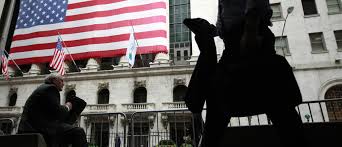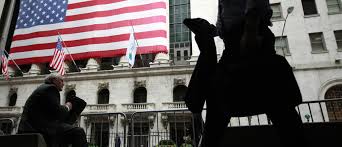
In a potential setback to President Donald Trump's promise to boost growth, as consumer spending barely increased and businesses invested less on inventories, the U.S. economy grew at its weakest pace in three years in the first quarter.
The Commerce Department said on Friday that as the government cut back on defense spending, gross domestic product increased at a 0.7 percent annual rate also.
In the fourth quarter, the economy grew at a 2.1 percent pace. The GDP rising at a 1.2 percent pace last quarter was forecast by economists polled by Reuters.
However, not a true picture of the economy's health was the pedestrian first-quarter growth pace. Suggestions that the mostly weather-induced sharp slowdown in consumer spending is probably temporary is made by the facts that the labor market is near full employment and consumer confidence is near multi-year highs.
Last quarter, a measure of private domestic demand increased at a 2.2 percent rate. Because of difficulties with the calculation of data that the government has acknowledged and is working to rectify, first-quarter GDP tends to underperform.
Without increases in productivity, economists say it would be difficult for Trump to fulfill his pledge to raise annual GDP growth to 4 percent even without the seasonal quirk and temporary restraints.
To achieve his goal of faster economic growth, Trump is targeting infrastructure spending, tax cuts and deregulation. Cutting the corporate income tax rate to 15 percent from 35 percent was part of the proposed tax plan by the Trump administration.
Accounting for more than two-thirds of U.S. economic activity, and braked to a 0.3 percent rate in the first quarter was growth in consumer spending. That followed the fourth quarter's robust 3.5 percent growth rate and was the slowest pace since the fourth quarter of 2009.
A mild winter, which undermined demand for heating and utilities production, was to be blamed for the weakness in consumer spending.
Also, curbing consumer spending was government delays issuing income tax refunds to combat fraud. But consumer spending is likely to pick up with savings rising to $814.2 billion from $778.9 billion in the fourth quarter.
When they meet next week, both the anemic consumer spending and GDP growth are likely to be viewed as temporary by Federal Reserve officials, economists believe. Quarterly GDP has been previously described as "noisy" by Fed Chair Janet Yellen.
The Fed is not expected to raise interest rates next week. The U.S. central bank has forecast two more hikes this year after it lifted its overnight interest rate by a quarter of a percentage point in March.
Inventory investment was a drag in the first quarter, after contributing to GDP growth for two straight quarters.
Down from $49.6 billion in the October-December period, businesses accumulated inventories at a rate of $10.3 billion in the last quarter. Almost reversing the 1.0 percentage point contribution in the fourth quarter, inventories subtracted 0.93 percentage point from GDP growth.
As defense outlays declined at a 4.0 percent pace, the biggest drop since the fourth quarter of 2014 was noted by government spending which fell at a 1.7 percent rate. State and local government investment also fell.
(Source:www.reuters.com)
The Commerce Department said on Friday that as the government cut back on defense spending, gross domestic product increased at a 0.7 percent annual rate also.
In the fourth quarter, the economy grew at a 2.1 percent pace. The GDP rising at a 1.2 percent pace last quarter was forecast by economists polled by Reuters.
However, not a true picture of the economy's health was the pedestrian first-quarter growth pace. Suggestions that the mostly weather-induced sharp slowdown in consumer spending is probably temporary is made by the facts that the labor market is near full employment and consumer confidence is near multi-year highs.
Last quarter, a measure of private domestic demand increased at a 2.2 percent rate. Because of difficulties with the calculation of data that the government has acknowledged and is working to rectify, first-quarter GDP tends to underperform.
Without increases in productivity, economists say it would be difficult for Trump to fulfill his pledge to raise annual GDP growth to 4 percent even without the seasonal quirk and temporary restraints.
To achieve his goal of faster economic growth, Trump is targeting infrastructure spending, tax cuts and deregulation. Cutting the corporate income tax rate to 15 percent from 35 percent was part of the proposed tax plan by the Trump administration.
Accounting for more than two-thirds of U.S. economic activity, and braked to a 0.3 percent rate in the first quarter was growth in consumer spending. That followed the fourth quarter's robust 3.5 percent growth rate and was the slowest pace since the fourth quarter of 2009.
A mild winter, which undermined demand for heating and utilities production, was to be blamed for the weakness in consumer spending.
Also, curbing consumer spending was government delays issuing income tax refunds to combat fraud. But consumer spending is likely to pick up with savings rising to $814.2 billion from $778.9 billion in the fourth quarter.
When they meet next week, both the anemic consumer spending and GDP growth are likely to be viewed as temporary by Federal Reserve officials, economists believe. Quarterly GDP has been previously described as "noisy" by Fed Chair Janet Yellen.
The Fed is not expected to raise interest rates next week. The U.S. central bank has forecast two more hikes this year after it lifted its overnight interest rate by a quarter of a percentage point in March.
Inventory investment was a drag in the first quarter, after contributing to GDP growth for two straight quarters.
Down from $49.6 billion in the October-December period, businesses accumulated inventories at a rate of $10.3 billion in the last quarter. Almost reversing the 1.0 percentage point contribution in the fourth quarter, inventories subtracted 0.93 percentage point from GDP growth.
As defense outlays declined at a 4.0 percent pace, the biggest drop since the fourth quarter of 2014 was noted by government spending which fell at a 1.7 percent rate. State and local government investment also fell.
(Source:www.reuters.com)














